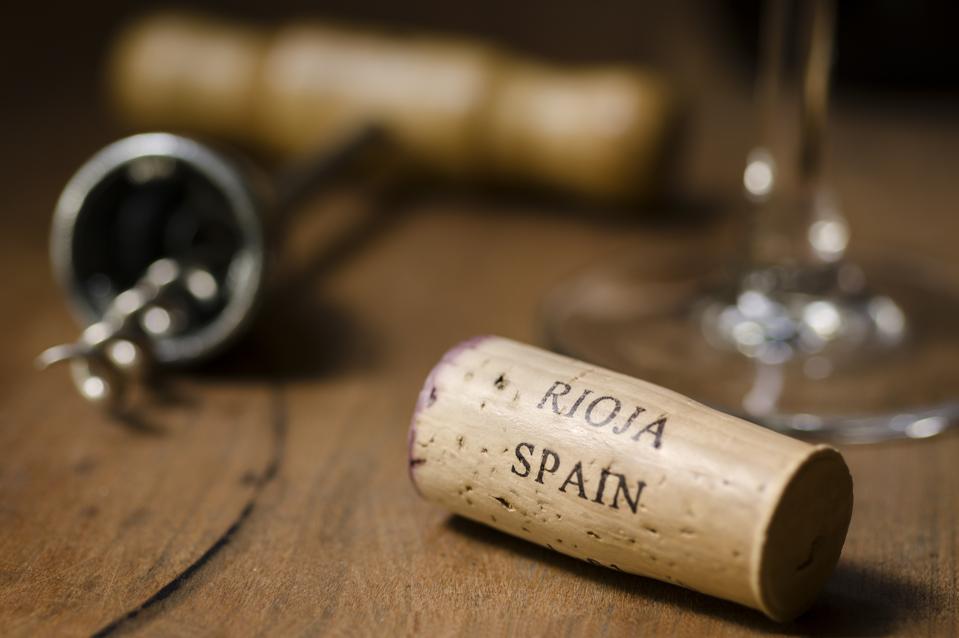
“A wine cork from the Rioja province of Spain with a corkscrew, stemmed glass and bottom of a wine bottle in the background.”
getty
If you’ve ever stared at a Spanish wine label and found yourself puzzling over the words Crianza, Reserva, or Gran Reserva, you’re not alone. These terms, printed proudly on bottles from Rioja to Ribera del Duero, are more than just decorative flourishes—they’re shorthand for how long the wine has been aged before release, and they can tell you a lot about what to expect in your glass.
The Spanish System: Tradition in a Bottle
High angle view of delicious appetizer shot on rustic wooden table. The composition includes a selection of cheeses, Iberico ham, Spanish chorizo, red wine, grapes, olives and bread. A red wineglass is on foreground and the cheese board is out of focus at background. Predominant colors are red, yellow and brown. XXXL 42Mp studio photo taken with Sony A7rii and Sony FE 90mm f2.8 macro G OSS lens
getty
Unlike many other major wine-producing countries (looking at you France and Italy) that ahve rules based on where their wines are made, Spain takes things a step further by setting rules for how long they must age before being released as well. These regulations are part of the country’s Denominación de Origen (DO) system, which serves as both a quality guarantee and a way to preserve the traditional character of each region.
The DO system defines everything from permitted grape varieties and production methods to how long a wine must rest in oak barrels and in the bottle. The idea is to maintain consistency and showcase each region’s unique expression of climate, soil, and craftsmanship—so a Rioja Reserva, for example, should always deliver a recognizable profile that reflects Rioja’s history and terroir.
While the exact requirements can vary slightly across Spain’s many DOs, most red wines follow a similar hierarchy based on aging time. The system ranges from Joven (young wines meant to be enjoyed right away) to Crianza, Reserva, and Gran Reserva—each step up the ladder representing more time, care, and complexity before the bottle ever reaches your table.
Crianza: Fresh and Approachable
Young Vineyard farmer filling truck of harvested red grapes
getty
A Crianza red is typically aged for a minimum of two years, with at least six months in oak (in Rioja, it’s one full year in oak). These are the bright, fruit-forward wines meant to be enjoyed sooner rather than cellared—think cherry, plum, and gentle spice, often with supple tannins and a silky finish. A Crianza Tempranillo from Rioja or Ribera del Duero pairs beautifully with weeknight dishes like roasted chicken or chorizo pasta.
Reserva: Balance and Complexity
Winery workers treading red wine
getty
Reserva wines age for at least three years before they’re sold, including a full year in oak barrels and more time resting in the bottle before release. By the time they reach store shelves, they’ve mellowed and gained layers of flavor—think blackberry, leather, vanilla, and a touch of tobacco. This is where Spain’s winemaking skill really shows, balancing the warmth of oak with the purity of the fruit. A Rioja Reserva often strikes that perfect middle ground between freshness and maturity, making it one of the best values in fine wine today.
Gran Reserva: Time and Elegance
A glass of red wine held up for a toast on a rooftop overlooking the beautiful cityscape of Madrid, Spain.
getty
Gran Reserva is the top tier—wines that have been aged at least five years, including two years in oak and three in bottle. These are typically made only in outstanding vintages and from the best fruit. The result? Deeply layered wines that feel almost timeless—aromas of dried fig, cigar box, cedar, and balsamic unfold in slow, luxurious waves. A Gran Reserva is less about fruit and more about finesse, patience, and the pleasure of savoring history in a glass.
What About Whites and Rosés?
Cropped image of man filling wine from storage tank in winery
getty
Though less common, Crianza, Reserva, and Gran Reserva designations exist for white and rosé wines, too—just with shorter aging requirements. A white Reserva Rioja, for example, might age two years total, with six months in oak, developing nutty, honeyed notes that rival some Burgundian Chardonnays.
The Takeaway
Spanish food: Manchego cheese slices and pieces in a cutting board shot on dark rustic wooden table. A red wine glass is beside the Manchego pieces. Spanish chorizo is visible at the left. A bowl filled with olives, bread and green grapes complete the composition. Predominant colors are brown and yellow. Low key DSRL studio photo taken with Canon EOS 5D Mk II and Canon EF 100mm f/2.8L Macro IS USM.
getty
Understanding these aging terms is like learning a new dialect of Spanish wine—it gives you insight into style, texture, and when to open that bottle. Whether you’re popping a lively Crianza with tapas or decanting a regal Gran Reserva for a celebration, you’ll know exactly what story your wine is telling—and why patience, in Spain, is as much an ingredient as the grape itself.


Dining and Cooking